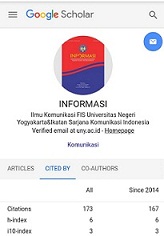Which internet content is often used and influenced behavior? A phenomenology about students in senior high school
DOI:
https://doi.org/10.21831/informasi.v53i2.67102Abstract
At present, most students in the world, as well as Indonesia, especially senior high school students, have used the Internet for various purposes. Internet content presented on different platforms can now be accessed easily. Consciously or not, this media content influences their behavior. There is a lot of freely submitted content, which is worth knowing the impact. The question related to this study is which internet content is often used and affects high school students' behavior. Qualitative methods with phenomenology have informants from the western, central, and eastern parts of Indonesia. Data were collected using observation, Google Forms, and interviews for the selected. It uses a sampling technique of 39 informants. The validity of the research used is source triangulation in the next stage, namely analyzing data with Milles & Huberman interactive analysis. Data analysis carried out is data collection, data reduction, data presentation, and conclusion. Content often used is entertainment and educational content, while content that can influence behavior is entertainment, education, health, food and cuisine, religious, beauty, motivational, art, and game content. The content is accessed through various platforms such as social media: YouTube, TikTok, Instagram, Twitter, podcasts, etc.
References
APJII. (2022). Profil internet Indonesia 2022. Tersedia di https://apjii.or.id/
Denzin, N. K. & Lincoln, Y. S. (2009). Handbook of qualitative research. Pustaka Pelajar.
Dwiningrum, S. I. A. (2016). Pendidikan sosial budaya. UNY Press.
Freire, P., et.al. (2006). Pendidikan kaum tertindas. LP3ES
Hansen, J. & Genschow, O. (2020). Psychological distance and imitation. Social and Personality Psychology Compass. https://doi.org/10.1111/spc3.12564
Hariyadi & Arliman, L. (2018). Peran orangtua dalam mengawasi anak dalam mengakses media internet untuk mewujudkan perlindungan hak anak. Soumatera Law Review, 1(2). http://ejournal.kopertis10.or.id/index.php/soumlaw
IG. A. A. Widiari widyaswari & IG. N. Widnyana. (2018). Sosial media sebagai sarana kreasi dan ekspresi karya seni rupa dan desain. Prasi, 13(2).
Irianto, A. M. (2015). Interaksionisme simbolik. Gigih Pustaka Mandiri.
Kemkominfo. (2021). 98 persen anak dan remaja tahu internet. Berita Kominfo. Tersedia di https://kominfo.go.id/index.php/content/detail/3836/98+Persen+Anak+dan+Remaja+Tahu+Internet/0/berita_satker
Koentjaraningrat. (1985). Pengantar ilmu antropologi. Aksara Baru.
Kuswarno, E. (2009). Metodologi penelitian komunikasi fenomenologi konsepsi, pedoman dan contoh penelitiannya. Widya Padjadjaran.
Latif, Y. (2020). Pendidikan yang berkebudayaan histori, konsepsi, dan aktualisasi pendidikan transformatif. PT. Gramedia Pustaka Utama.
Lin, N. (2021). Research on the influence of the Internet on teenagers' psychology and behavior. Advances in Social Science, Education and Humanities Research, volume 554 Proceedings of the 7th International Conference on Humanities and Social Science Research (ICHSSR 2021).
Lintang & Wahyudi. (2017). Tata kelola konten internet di Indonesia: kebijakan, praktik, dan permasalahannya. Lembaga Studi dan Advokasi Masyarakat (ELSAM).
Miles, M. B. & Huberman, A. M. (1992). Analisis data kualitatif. UI Press.
Moleong, L. J. (2008). Metodologi penelitian kualitatif. Remaja Rosdakarya.
Mooney, L. A. et.al. (2016). Understanding social problems. Cengage Learning.
Munir. (2017). Pembelajaran digital. Bandung: Alfabeta.
Nakamura, L. et.al. (2018). "Free" internet content: web 1.0, web 2.0 and the sources of economic growth. The 35th IARIW General Conference Copenhagen, Denmark.
Ngonso, B. (2019). Effect of social media on teenagers and youths: a study of rural nigerian teenagers and youths in secondary schools. Global Media Journal, 17 (32).
Ojo, A. O. et.al. (2019). Ability, motivation, opportunity and sociodemographic determinants of Internet usage in Malaysia. Sage Journals https://doi.org/10.1177/0266666918804859.
Osborne, R. & Loon, B. V. (2005). Sosiologi. Scientific Press.
Panova, T. & Carbonell, X.(2018). Is smartphone addiction really an addiction?. Journal of Behavioral Addictions, 7(2), 252–259. DOI: 10.1556/2006.7.2018.49 June 12
Patton, M. Q. (2009). Metode evaluasi kualitatif. Pustaka Pelajar.
Pnuju, P. & Umami, I. (2005). Psikologi remaja. PT. Tiara Wacana Yogya.
Retnowati, H. (2016). Analisis kuantitatif instrumen penelitian (panduan peneliti, mahasiswa, dan psikometrian). Parama Publishing.
Ritzer, G. & Goodman, D. J. (2009). Teori sosiologi dari teori sosiologi klasik sampai perkembangan mutakhir teori sosial postmodern. Kreasi Wacana.
Rusman, Kurniawan, D. & Riyana, C. (2013). Pembelajaran berbasis teknologi informasi dan komunikasi mengembangkan profesionalitas guru. Rajawali Pers.
Santrock, J. W. (2019). Life-Spain development. Mc.Grow Hill Education.
Suranto, et.al. (2020). Parenting and sharenting communication for preventing juvenile delinquency. Informasi, 50(2), 177-186. doi: http://doi.org/10.21831/informasi.v50i2.36847
Susanto, O. B., et.al. (2020). The influence of knowledge and perception levels and inter personal communication toward violent behavior in teenager relationship. International Journal of New Economics and Social Sciences, 11(1).
Umam, K. (2018). Perilaku organisasi. Pustaka Setia.
Undang-undang No. 19 tahun 2016 about Information and Electronic Transactions
Usman, S. (2018). Modal sosial. Pustaka Pelajar.
Vansteenkiste, M. et.al. (2020). Basic psychological need theory: Advancements, critical themes, and future directions. Journal Motivation and Emotion, 44, 1–31 https://doi.org/10.1007/s11031-019-09818-1.
Downloads
Published
How to Cite
Issue
Section
Citation Check
License
Authors who publish with this journal agree to the following terms:
- Authors retain copyright and grant the journal right of first publication with the work simultaneously licensed under a Creative Commons Attribution License that allows others to share the work with an acknowledgement of the work's authorship and initial publication in this journal.
- Authors are able to enter into separate, additional contractual arrangements for the non-exclusive distribution of the journal's published version of the work (e.g., post it to an institutional repository or publish it in a book), with an acknowledgement of its initial publication in this journal.
- Authors are permitted and encouraged to post their work online (e.g., in institutional repositories or on their website) prior to and during the submission process, as it can lead to productive exchanges, as well as earlier and greater citation of published work (See The Effect of Open Access).











